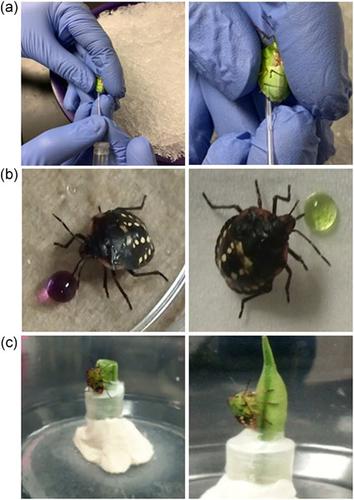当前位置:
X-MOL 学术
›
Arch. Insect Biochem. Physiol.
›
论文详情
Our official English website, www.x-mol.net, welcomes your feedback! (Note: you will need to create a separate account there.)
Transport of orally delivered dsRNA in southern green stink bug, Nezara viridula.
Archives of Insect Biochemistry and Physiology ( IF 2.2 ) Pub Date : 2020-05-22 , DOI: 10.1002/arch.21692 Dhandapani Gurusamy 1, 2 , Jeffrey L Howell 1 , Shankar C R R Chereddy 1 , Jinmo Koo 1 , Subba Reddy Palli 1
Archives of Insect Biochemistry and Physiology ( IF 2.2 ) Pub Date : 2020-05-22 , DOI: 10.1002/arch.21692 Dhandapani Gurusamy 1, 2 , Jeffrey L Howell 1 , Shankar C R R Chereddy 1 , Jinmo Koo 1 , Subba Reddy Palli 1
Affiliation

|
The southern green stink bug (SGSB, Nezara viridula) is an emerging polyphagous pest in many regions of the world. RNA interference (RNAi) is a valuable method for understanding gene function and holds great potential for pest management. However, RNAi efficiency is variable among insects and the differences in transport of double‐stranded RNA (dsRNA) are one of the major factors that contribute to this variability. In this study, Cy3 labeled dsRNA was used to track the transport of dsRNA in SGSB tissues. Cy3_dsRNA was detected in the hemocytes, fat body (FB), epidermis, and midgut tissues at 24–72 hr after injection. Orally delivered Cy3_dsRNA or Cypher‐5E labeled dsRNA was mostly detected in the midgut and a few signals were detected in parts of the FB and epidermis. Both injected and fed Cy3_dsRNA showed stronger signals in SGSB tissues when compared to Cy3_siRNA (small interfering RNA) or Cy3_shRNA (short hairpin RNA). dsRNA targeting the gene for a vacuolar‐sorting protein, SNF7, induced higher knockdown of the target gene and greater SGSB mortality compared to siRNA or shRNA targeting this gene. 32P‐labeled dsRNA injected into SGSB was processed into siRNA, but fed 32P‐labeled dsRNA was not efficiently processed into siRNA. These data suggest that transport of orally delivered dsRNA across the midgut epithelium is not efficient in SGSB which may contribute to variable RNAi efficiency. Targeting genes expressed in the midgut rather than other tissues and using dsRNA instead of siRNA or shRNA would be more effective for RNAi‐mediated control of this pest.
中文翻译:

口服递送的dsRNA在南方绿色臭虫Nezara viridula中的运输。
南部的绿色臭虫(SGSB,内扎拉绿毛虫)是世界许多地区的新兴多食性害虫。RNA干扰(RNAi)是了解基因功能的宝贵方法,在有害生物管理方面具有巨大潜力。但是,昆虫之间的RNAi效率是可变的,双链RNA(dsRNA)的运输差异是导致这种变异性的主要因素之一。在这项研究中,使用Cy3标记的dsRNA来跟踪dsRNA在SGSB组织中的运输。注射后24–72小时,在血细胞,脂肪体(FB),表皮和中肠组织中检测到Cy3_dsRNA。口服递送的Cy3_dsRNA或Cypher-5E标记的dsRNA大多在中肠中检测到,在部分FB和表皮中检测到一些信号。与Cy3_siRNA(小干扰RNA)或Cy3_shRNA(短发夹RNA)相比,注射和饲喂的Cy3_dsRNA在SGSB组织中均显示出较强的信号。靶向空泡分选蛋白基因的dsRNA,与靶向该基因的siRNA或shRNA相比,SNF7诱导了更高的目标基因敲低和更高的SGSB死亡率。注入SGSB的32 P标记的dsRNA被加工成siRNA,但进料的32 P标记的dsRNA没有被有效地加工成siRNA。这些数据表明,口服递送的dsRNA跨中肠上皮的运输在SGSB中效率不高,这可能会导致可变的RNAi效率。靶向中肠而不是其他组织中表达的基因,并使用dsRNA代替siRNA或shRNA将对RNAi介导的这种害虫控制更为有效。
更新日期:2020-05-22
中文翻译:

口服递送的dsRNA在南方绿色臭虫Nezara viridula中的运输。
南部的绿色臭虫(SGSB,内扎拉绿毛虫)是世界许多地区的新兴多食性害虫。RNA干扰(RNAi)是了解基因功能的宝贵方法,在有害生物管理方面具有巨大潜力。但是,昆虫之间的RNAi效率是可变的,双链RNA(dsRNA)的运输差异是导致这种变异性的主要因素之一。在这项研究中,使用Cy3标记的dsRNA来跟踪dsRNA在SGSB组织中的运输。注射后24–72小时,在血细胞,脂肪体(FB),表皮和中肠组织中检测到Cy3_dsRNA。口服递送的Cy3_dsRNA或Cypher-5E标记的dsRNA大多在中肠中检测到,在部分FB和表皮中检测到一些信号。与Cy3_siRNA(小干扰RNA)或Cy3_shRNA(短发夹RNA)相比,注射和饲喂的Cy3_dsRNA在SGSB组织中均显示出较强的信号。靶向空泡分选蛋白基因的dsRNA,与靶向该基因的siRNA或shRNA相比,SNF7诱导了更高的目标基因敲低和更高的SGSB死亡率。注入SGSB的32 P标记的dsRNA被加工成siRNA,但进料的32 P标记的dsRNA没有被有效地加工成siRNA。这些数据表明,口服递送的dsRNA跨中肠上皮的运输在SGSB中效率不高,这可能会导致可变的RNAi效率。靶向中肠而不是其他组织中表达的基因,并使用dsRNA代替siRNA或shRNA将对RNAi介导的这种害虫控制更为有效。



























 京公网安备 11010802027423号
京公网安备 11010802027423号